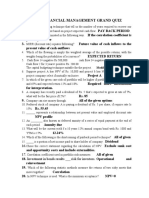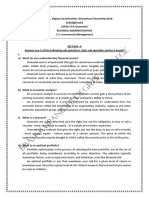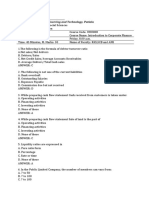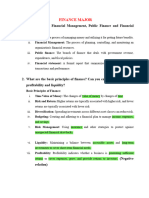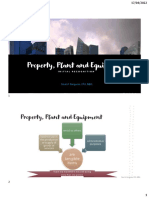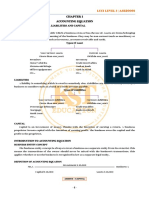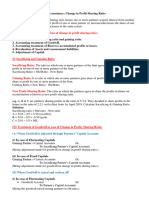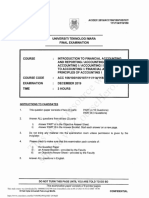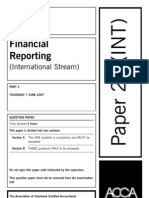FRFI Tutorial
1. Investment appraisal techniques involve the discounting of a project’s future
cash flows to present value using appropriate discount rates.
a. The NPV technique compares discounted periodic cash flows with the
present value of the capital outlay and requires that projects with
NPV>0 be accepted and that those with NPV<0 be rejected.
What is the underlying reason for accepting and/or rejecting?
b. The IRR technique requires that project with IRR greater than cost of
capital be accepted and that those with IRR less than cost of capital be
rejected. Explain why this is so.
2. Define risk diversification. It is often said that a well-diversified portfolio
reduces the overall risk and optimises portfolio returns. Explain the reasons
behind risk reduction and return maximisation.
3. A firm has the following details relating to its capital structure:
Debt Capital K20m, Equity Capital K80m. Investors require 20% on their
investment in shares while the debt was contracted at an interest rate of
25%. The company pays tax at the rate of 30%. What is the discount rate that
the firm would use to discount cash its flows for investment appraisal
purposes.
4. The following information is given about a stock:
Market Return = 15%
Risk Free Rate = 10%
Beta Factor = 1.2
Use the Capital Asset Pricing Model (CAPM) to compute the expected return
on this stock.
5. Define the term Risk Premium.
6. A stock has the following characteristics:
Return on Market Portfolio = 11%
Beta Factor = 0.5
Expected Return on the stock is 16%.
Calculate the risk premium.
7. Define diversifiable risk and contrast it with non-diversifiable risk.
8. What is the meaning of Beta Factor?
9. With respect to financial derivatives, what is the meaning of premium?
10.An option confers the right but not an obligation to buy or sell an underlying
asset as a price (exercise price) agreed today, at a specified future date.
Explain which party has an obligation to buy or sell at expiration and which
party has no obligation.
11.With regard to derivatives, what is the formula for the payoff of:
a. A call option?
� b. A put option?
12.Given a call option with the following details:
Premium = K4
ST = K50
X = K65
Should the option holder exercise or lapse this option at expiration? Give
reasons for your choice of answer.
13.What is the difference between an option and a forward contract?
14.Two parties sign a forward contract with the following details:
Premium = K20
ST = K100
X = K150
Compute the cash outflows and inflows and net payoff for each party to this
contract.
Explain why an option would be a better choice for a person anticipating to
buy an asset under rising prices.
15.Briefly explain how the risk management objective is achieved using:
a. A forward contract
b. An option
16.Define a Eurobond.
A Zambian company issues a bond to raise capital in London. The bond is
denominated in US Dollars. The same company also issues another US Dollar
denominated bond in New York. Identify which of these bonds is a Eurobond.
What is the name given to the other bond?
17.A Eurobond has a par value of $1,000. The annual coupon rate is 20% and it
has a tenure of 30 years. What is the price of the bond using a discount rate
of 10%?












